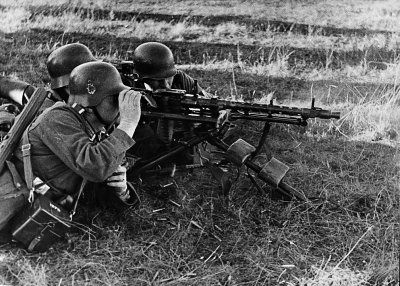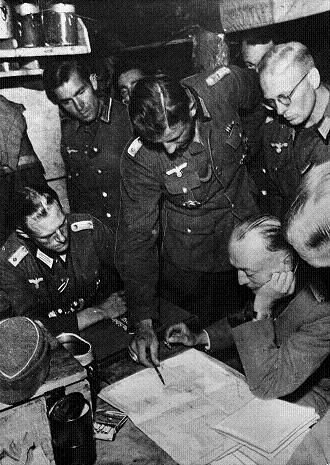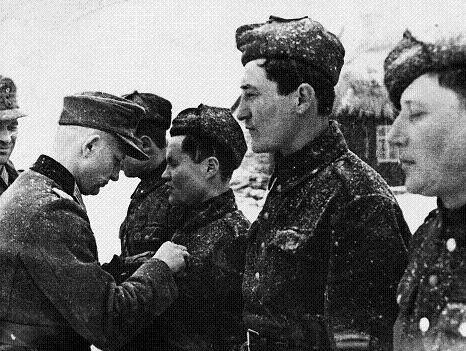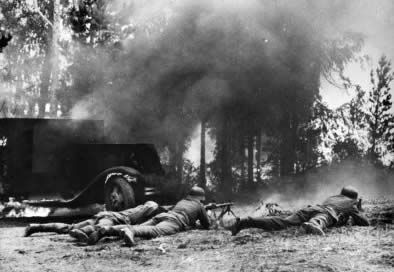The MG 34 machine gun

The dual-purpose MG 34 could be employed in both a light and heavy role, providing German infantry sections with greater tactical flexibility.
Because of its use in a light role, the weapon possessed the weight-saving system of an air-cooled barrel ventilated by holes in the sleeve, rather than the heavier jacket used to water-cool earlier heavy machine guns.
Since air-cooling remained less efficient than water-cooling, however, the relatively lightweight MG 34 was designed so that soldiers could easily change its barrel in the field. The gun possessed an impressive rate of fire of 820 rounds per minute (rpm) and could deliver rounds to an effective range of 6,564 ft (2,000 m). The weapon fired its rounds from either a 50-round belt or a saddle magazine.
The invasion of Norway

German infantry advance through a burning Norwegian village in April 1940.
The Norwegian campaign offered a number of operational and tactical lessons. For the most part German equipment and training proved excellent, and German initiative stood in sharp contrast to Anglo-French hesitation.
Occasional reverses, however, pointed to certain weaknesses in defensive doctrine, particularly under winter conditions as in the cases of Norwegian ski-borne attacks. As individuals, Norwegian soldiers generally proved better marksmen as well as skiers, but German superiority in automatic weapons generally compensated for this. Again, as after the Polish campaign, the Germans conducted a thorough evaluation of these and other issues. This time, however, also in light of the overwhelming victory in France, there seemed little need for substantial corrective action.
Junior officers planning an attack on the Eastern Front in October 1943

Most junior officers were not professional soldiers, and they had little interest in pursuing military careers after the war. They wanted Germany to win the war as quickly as possible so they could return home to their families and jobs. This meant that they largely remained in frontline units, instead of rising to serve as staff officers in higher headquarters.
Their embrace of Hitler and his Nazi Party meant that they were enthusiastic supports of the Führer’s war aims. There was little agonizing about Hitler’s conduct of the war in the frontline trenches. It was the job of the German Army to kill the Führer’s enemies and its junior officers were keen to finish the job they started in 1939. General Frido von Senger und Etterlin witnessed a medal ceremony for junior officers, where the Führer rewarded them for their bravery: “The impression made by Hitler was utterly depressing…. This man was still regarded by many of these young officers as a demigod, a man deserving in complete confidence, whose handshake inspired new confidence.”
An award ceremony for Wehrmacht soldiers on the Eastern Front

Maintenance of morale was not just a case of awarding medals. The efficient field postal service was more crucial: postage was free and letters sent from one end of Europe to the other rarely took more than a week. The daily mail call was always one of each day’s high points. In addition, men received food and ammunition on a regular basis, which also helped morale.
Every effort was made to provide for those wounded in battle: walking wounded made their own way to medical dressing stations, while the seriously wounded were stretchered to rear-area hospitals. Those wounded who required long-term care were shipped back to Germany in hospital trains. In addition, great efforts were made to retrieve the bodies of comrades killed in battle.
Infantry combat during Operation Barbarossa

German infantry fire on a Soviet bunker beside a burning Red Army GAZ AA or AAA armoured scout car during Operation Barbarossa in June 1941. The vehicle resembles a BA-10 armoured car, which was mounted on the AAA three axle chassis but this is clearly not one of these as it has a running board and they did not. The BA-10 also had a 50mm gun in a turret. There are no signs of the type of damage that the blowing off of a turret would cause.
The vehicle is thus an improvised armoured scout car on a GAZ truck chassis. Note German troops with MG 34 machine gun.
